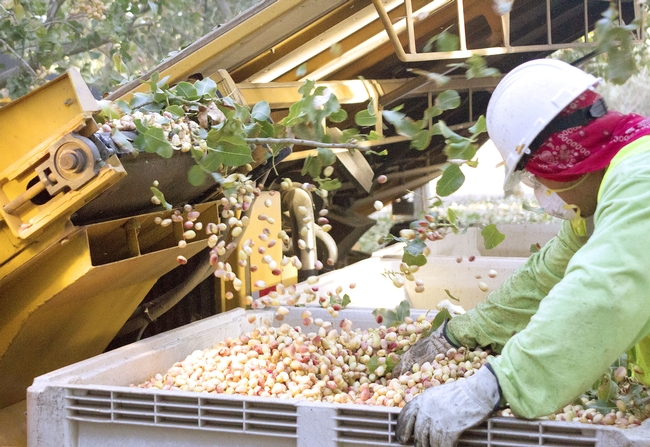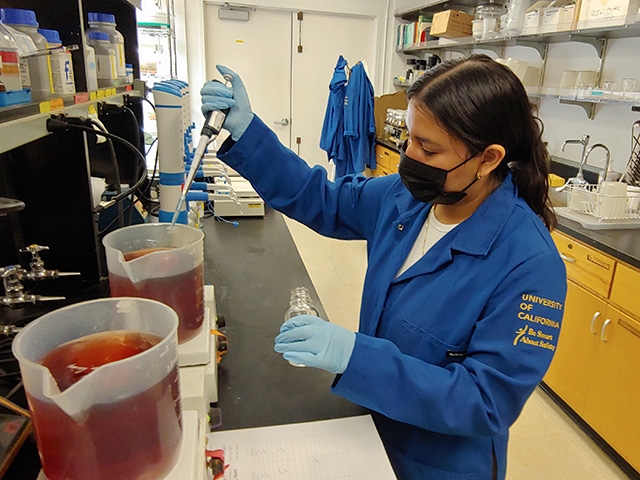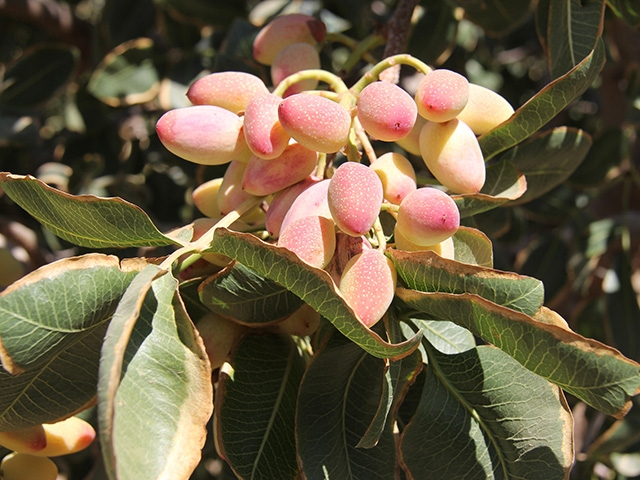
Posts Tagged: Giulia Marino
NIFA funds $3.8 million project to find climate-resilient pistachio trees
Growers invited to participate in study by sharing their experiences
A multi-state team led by Patrick J. Brown has been awarded nearly $3.8 million over the next four years for a project to improve pistachio production as the industry faces warmer winters and scarcer water.
“We are at this unique point in history where we can do this,” said Brown, an associate professor in the UC Davis Department of Plant Sciences.
The project aims to ensure the industry can thrive in coming decades despite the challenges faced. Growers are invited to participate in the study, sharing what they already are trying in their own fields or supporting any aspect of the project. To discuss the possibilities, contact Brown at pjbrown@ucdavis.edu or (530) 752-4288.
The project includes research to ensure pollination, experiments to calculate irrigation needs amid water shortages, creating tools to improve public breeding programs, developing more efficient harvesting equipment, and economic analyses to ensure future pistachio cultivation is economically rewarding. Researchers hope to offer a guide for growers deciding whether to plant new orchards or remove existing ones.
“The success of California's pistachio industry, which is the top producer of the nuts in the world, has always relied on a strong collaboration between UC researchers and pistachio growers,” said project participant Florent Trouillas, a UC Cooperative Extension specialist in the UC Davis Department of Plant Pathology. “Research efforts must continue to address enduring and new challenges, improve sustainability and ensure the profitability of pistachio farming.”
The tasty, green nuts have blossomed into a $5.2-billion industry in California, thanks to their greater tolerance of dry lands and salty soils. The project aims to further improve their climate resilience by finding a rootstock that can thrive despite growing water scarcity and declining water quality projected over the next half-century. With millions of genetically distinct pistachio trees growing in the state, "we already have out there what may be the industry's next great rootstock," Brown said. "It's probably in some grower's field already. We just have to find it."
Researchers seek to pair that new rootstock with high-yielding scions – the producing part of the tree grafted onto the rootstock – to develop new combinations that can thrive in the different conditions across the state.
Trouble with “boy meets girl”
Pistachios, like many other tree crops, have male and female trees, and they require hundreds of hours of wintertime temperatures below 45 degrees Fahrenheit for the trees to flower in the spring. Wind blows the pollen from male flowers to female flowers, creating nuts.
Complicating the timing: Boy flowers and girl flowers generally require different amounts of winter cold to bloom. After a sufficiently cold winter, boys and girls flower together. But if the winter is warm, most of them will flower at different times, reducing pollination.
That happened in the winter of 2014-15, which saw unusually warm winter temperatures. The following fall, farmers harvested only half their expected crop, losing more than $1 billion, Brown said. Climate change is expected to provoke progressively warmer winters in the future, on average.
An additional complication: The boy scions come from a single variety, or cultivar, and the girl scions come from another single cultivar. "In California part of the problem is that we have been relying on a single male and single female cultivar," Brown explained.
A key part of this project will be to test new scions that can pollinate efficiently despite warmer winters. “We now have additional male and female scions released in the last 10 to 15 years, but we need more information on their chill requirements,” Brown said.
Growing importance of pistachio sector
With nearly 520,000 acres planted in California in 2021, pistachios are the fastest-growing tree nut crop in the state. Growers have doubled their plantings over the past decade, due to pistachios' drought tolerance and higher gross returns compared to other nuts, experts report. California dominates the industry, growing 99 percent of the nation's crop and nearly 60 percent of the world's crop, employing people in 47,000 full-time-equivalent jobs and creating $5.2-billion of total economic impact in 2020, according to American Pistachio Growers.
Brown's team is part of a wider effort at UC Davis to support the sector's growth and adaptation to climate change. Other department members participating in the project include co-directors Louise Ferguson, a UC Cooperative Extension pomologist, and Richard W. Michelmore, a distinguished professor and director of the UC Davis Genome Center. Also participating are Giulia Marino, a UC Cooperative Extension specialist; and Grey Monroe, an assistant professor.
Other UC Davis participants include Trouillas and Brittney Goodrich, a UC Cooperative Extension specialist in the Department of Agricultural and Resource Economics. The project also includes researchers from UC Merced, New Mexico State University and Purdue University.
The four-year project was among nearly $70 million in Specialty Crop Research Initiative grants awarded this fall by the National Institute of Food and Agriculture. The Department of Plant Sciences landed three of the 25 grants.
Read the NIFA grant summary.
UC ANR names Marino, Culumber Presidential Chairs for Tree Nuts
Two UC Cooperative Extension scientists have been selected as Presidential Chairs for Tree Nuts at University of California Agriculture and Natural Resources.
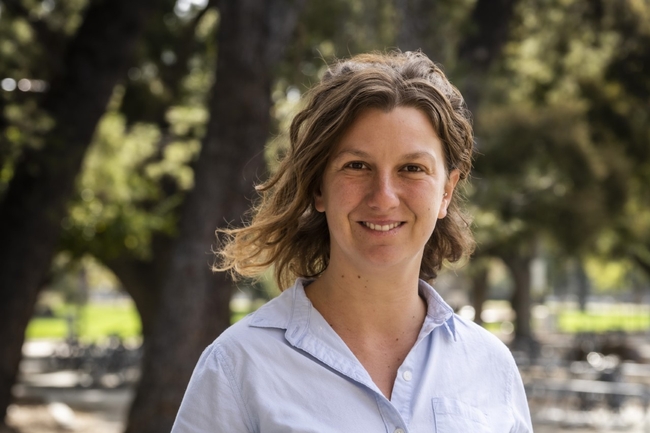
The endowed chairs will give the two scientists a dedicated source of funding for five years for their ongoing agricultural research. UC Agriculture and Natural Resources established the two $1 million endowments in 2015. Half of the funds for the endowed chairs was donated by the California Pistachio Research Board and the other half was provided by UC Office of the President.
“The California Pistachio Research Board appreciated the opportunity to create these Presidential Chairs with the dedicated flexible funding it provides the scientists,” said Bob Klein, manager of the California Pistachio Research Board. “Mae and Giulia have stellar research records, have a history of research on California pistachios, and deserved both consideration and the award of these Chairs. The Board was pleased with the previous incumbents and is now looking forward to working with both Giulia and Mae in their programs on Genetics and Soil Science/Water Relations.”
Marino, who joined UC ANR in 2020, is based at UC Kearney Agricultural Research & Extension Center in Parlier. Her research integrates germplasm preservation and evaluation with tree physiology to improve orchard system profitability and abiotic-stress resilience. She explores the interactions between cultivar-rootstock traits, soil conditions and management practices.
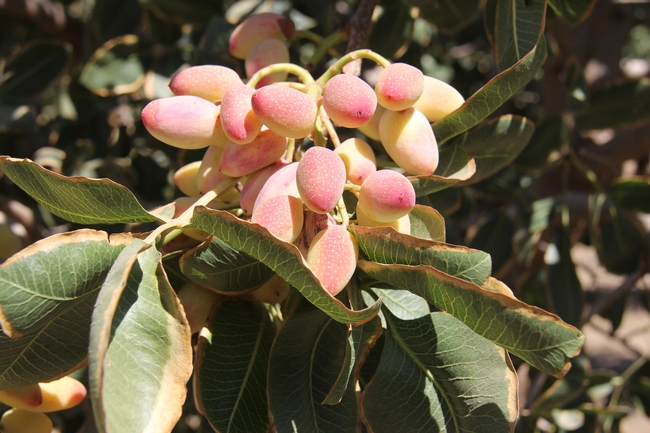
“The program has the objectives of increasing the genetic diversity of the scion and rootstock cultivars used by the pistachio industry to improve grower returns and reduce its susceptibility to climate change,” Marino continued. “Rootstock projects include novel rootstocks more tolerant of boron in irrigation water, dwarfing rootstocks for higher early yields and more efficient use of pruning and harvest inputs. Scion objectives include novel scions for higher yield and trees less sensitive to inadequate winter chilling.”
One of her current research lines focuses on the characterization of low vigor cultivars and/or rootstocks to increase orchard planting density and reduce management costs in olive, pistachio and almond. She develops protocols for irrigation management based on genotype-specific physiological responses to water stress. Marino also studies the impact of saline sodic soil conditions on pistachio physiology and of low winter chill on cherry and pistachio tree and fruit physiology.
Marino earned a doctoral degree in fruit and forestry tree systems and master's and bachelor's degrees in agricultural science, all from the University of Palermo in Italy.

“As Presidential Chair, I will utilize these generous funds from the Pistachio Research Board to augment my collaborative outreach extension and applied research efforts to understand
and develop solutions to soil and water quality problems faced by pistachio growers and other nut crop producers across the San Joaquin Valley,” Culumber said.
She is collaborating on a CDFA Fertilizer Research and Education Program project that provides irrigation and nitrogen management training for certified crop advisors and growers to adopt practices that conserve water and protect water quality. She is also studying how to improve estimates of crop evapotranspiration and forecasting for major California crops for more precise irrigation. Culumber is leading research on the effects of whole orchard recycling on air quality and climate resilience, soil health, tree growth and productivity in second-generation orchards.
Culumber earned a Ph.D. in soil science and agroecology and a master's in plant science and molecular ecology, both from Utah State University, and a bachelor's in biology from University of Wisconsin-Stevens Point.
Bruce D. Lampinen, UC Cooperative Extension integrated orchard management, walnut and almond specialist in the UC Davis Department of Plant Sciences, received the first Presidential Chair for Tree Nut Soil Science and Plant Water Relations. Craig Kallsen, UC Cooperative Extension farm advisor in Kern County who specializes in fruit and nut crops, received the Presidential Chair for Tree Nut Genetics.

